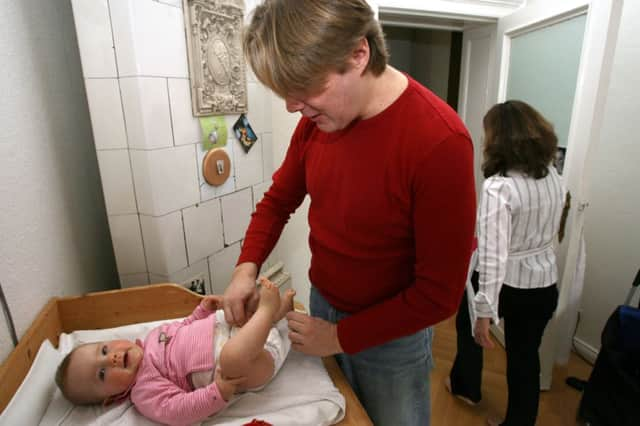Tackling inequality means serious money


First Minister Nicola Sturgeon set out her stall to business leaders last week with the aim of making Scotland more competitive while finding ways of fighting social deprivation and inequality. In many ways, she is to be applauded for confronting a deep-rooted national problem that is holding back the country’s economy. For business, there is always a fine line between funding the costs to the business of equality measures and making profits. Experts argue that a happier workforce is the best way to improve the nation’s productivity.
One measure which might achieve this is the recent law giving fathers extended paternity leave rights. This gives mums and dads the right to share up to 50 weeks’ leave, and 37 weeks’ statutory maternity pay, for babies or adoptions due on or after 5 April, 2015. This will be called shared parental leave and shared parental pay.
Advertisement
Hide AdAdvertisement
Hide AdOn the face of it, this achieves the aims of creating more equality rights for parents while not costing any more to business and the taxpayer overall. What’s not to like?
As you would expect, there are some procedural rules on the new regime. Firstly, shared leave cannot be taken within the compulsory period of maternity leave, ie, two weeks after childbirth. But fathers can still take their existing paternity leave. The shared leave can then be taken at any time after the first two weeks up until the baby’s first birthday.
There are also some new notice provisions for taking the shared parental leave. For example, employees must first give a non-binding notice of their rights, which includes details of both partners, the expected week of childbirth and how much leave and shared parental pay each employee intends to take. Employees must then give a further notice at least eight weeks before taking a period of leave which confirms the proposed leave dates and division of pay. When it comes to being paid, shared parental pay is the same as for statutory maternity or paternity pay – currently £138.18 per week – provided employees earn the lower earnings limit, £111 a week.
This means in almost all cases, the woman will take her maternity pay for the first six weeks because she is entitled to 90 per cent of her normal pay during this period. So, when it comes to cost, businesses will not have to pay any more than they do now. Also, unlike maternity or paternity leave, the new rights can be taken in three separate continuous or discontinuous blocks. Although employers can refuse a request for a discontinuous pattern, they cannot refuse continuous requests.
But overall, what will be the impact of the new rules and how many fathers will take advantage of the extended paternity rights? Where the mother is the main breadwinner, you could see fathers taking the shared parental leave. This might help to reduce the stigma of fathers working less and spending more time looking after the children.
Interestingly, the Government only expects there to be an uptake of 2-8 per cent by fathers who qualify, a paltry figure compared to nearly 40 per cent of fathers who take up their current two-week paternity leave entitlement. On these predictions, shared parental leave can hardly be said to be a huge advance on the fight against inequality.
The reality is that the provisions make absolutely no difference to the joint income of the family where the earnings of both partners are fairly low. In this scenario, the mother often goes back to work much sooner than she would wish because the statutory pay is too low. For these couples, it will not matter whether the father or mother takes the statutory pay as they will still struggle financially.
What would have a much bigger impact on inequality would be to increase significantly the statutory pay level. Alternatively, the period in which the mother gets 90 per cent of her earnings could be extended from six weeks to three to four months. This would give mothers much more incentive not to go back to work during this period.
Advertisement
Hide AdAdvertisement
Hide AdBut these kinds of measures would cost either the taxpayer or businesses much more than the new shared parental leave provisions. The real difficulty is that seriously tackling inequality involves serious money. The challenge to the First Minister will be to see whether the Scottish Government can indeed implement a pro-business and pro-equality agenda which has a significant impact in both spheres.
• Ben Thornber is a member of United Employment Lawyers, a collaborative network of 35 independent Scottish law firms www.unitedemploymentlawyers.co.uk/